 First edition (UK) | |
| Author | Bruce Marshall |
|---|---|
| Country | Scotland |
| Publisher | Constable (UK) Doubleday (US) |
Publication date | 1970 |
| Media type | Print (hardback) |
| Pages | 278 |
The Bishop is a 1970 novel by Scottish writer Bruce Marshall.
 First edition (UK) | |
| Author | Bruce Marshall |
|---|---|
| Country | Scotland |
| Publisher | Constable (UK) Doubleday (US) |
Publication date | 1970 |
| Media type | Print (hardback) |
| Pages | 278 |
The Bishop is a 1970 novel by Scottish writer Bruce Marshall.
This novel is a sort of 'inside look" at the workings of a fictional Roman Catholic Bishop's headquarters in the United Kingdom.
The central characters are Bishop Bede Jenkins; Father Spyers, a young, recently ordained priest who serves as the Bishop's secretary; Monsignor Basil Powell, the Vicar General, who was once a Major in the Grenadier Guards; and Monsignor Finbar O'Flaherty, the administrator of the pro-Cathedral.
The story opens as Father Spyers opens a new encyclical, Humanae Vitae, which prohibits Catholics the use of chemical birth control methods (physical methods had long been banned). The process of implementing perhaps the most controversial papal bull released during the Church's second millennium supplies most of the activities of the story. Marshall introduces us to the discussions and arguments within the Catholic community during this time. The Bishop finds himself embroiled in fights with his superiors over his methods of implementing the decree. Father Spyers spends time in the hospital after being struck down by an angry husband.
Subplots include Monsignor Powell's counseling of a nun who wishes to leave the convent, problems that the Bishop's friend, an Anglican Bishop, experiences and the irreligious attitude of modern Englishmen. The novel touches on modern literature, the treatment of animals, modern art, cultural differences and Father Spyers' daydreams of his future papacy (and chooses Benedict XVI as his title). [1]
Sedevacantism is a doctrinal position within traditionalist Catholicism, which holds that the present occupier of the Holy See is not a valid pope due to the Pope's espousal of one or more heresies and that, for lack of a valid pope, the See of Rome is vacant.
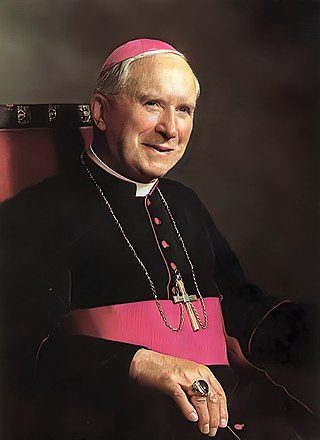
Marcel François Marie Joseph Lefebvre was a French Catholic archbishop who greatly influenced modern traditional Catholicism. In 1970, he founded the Society of Saint Pius X (SSPX), a community to train seminarians, in the village of Écône, Switzerland. In 1988, he was excommunicated from the Catholic Church for consecrating four bishops against the express prohibition of Pope John Paul II.

Ronald Arbuthnott Knox was an English Catholic priest, theologian, author, and radio broadcaster. Educated at Eton and Balliol College, Oxford, where he earned a high reputation as a classicist, Knox was ordained as a priest of the Church of England in 1912. He was a fellow and chaplain of Trinity College, Oxford until he resigned from those positions following his conversion to Catholicism in 1917. Knox became a Catholic priest in 1918, continuing in that capacity his scholarly and literary work.
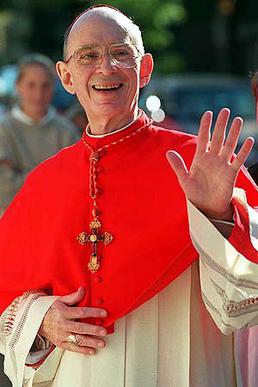
Joseph Louis Bernardin was an American Cardinal of the Catholic Church. He served as Archbishop of Cincinnati from 1972 until 1982, and as Archbishop of Chicago from 1982 until his death in 1996 from pancreatic cancer. Bernardin was elevated to the cardinalate in 1983 by Pope John Paul II.
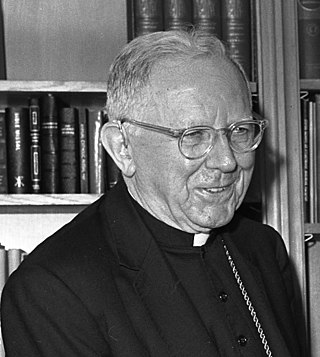
James Francis Aloysius McIntyre was an American prelate of the Roman Catholic Church. He served as Archbishop of Los Angeles from 1948 to 1970, and was created a cardinal in 1953. He was a highly successful builder of new parishes, churches, and schools. He was notable in Church politics, and his reputation remains highly controversial.

St Patrick's Pontifical University, Maynooth, is the "National Seminary for Ireland", and a pontifical university, located in the town of Maynooth, 24 km (15 mi) from Dublin, Ireland.

Monsignor Quixote is a novel by Graham Greene, published in 1982. The book is a pastiche of the classic 1605 and 1615 Spanish novel Don Quixote by Miguel de Cervantes with many moments of comedy, but also offers reflection on matters such as life after a dictatorship, Communism, and the Catholic faith.

Robert Hugh Benson AFSC KC*SG KGCHS was an English Catholic priest and writer. First an Anglican priest, he was received into the Catholic Church in 1903 and ordained therein the next year. He was also a prolific writer of fiction, writing the notable dystopian novel Lord of the World, as well as Come Rack! Come Rope!.
Major-General Sir Richard Hannay, KCB, OBE, DSO, is a fictional character created by Scottish novelist John Buchan and further made popular by the 1935 Alfred Hitchcock film The 39 Steps, very loosely based on Buchan's 1915 novel of the same name. In his autobiography, Memory Hold-the-Door, Buchan suggests that the character is based, in part, on Edmund Ironside, from Edinburgh, a spy during the Second Boer War.

Lieutenant-Colonel Claude Cunningham Bruce Marshall, known as Bruce Marshall was a prolific Scottish writer who wrote fiction and non-fiction books on a wide range of topics and genres. His first book, A Thief in the Night came out in 1918, possibly self-published. His last, An Account of Capers was published posthumously in 1988, a span of 70 years.

The Cathedral of St. John the Baptist is the mother church of the Roman Catholic Diocese of Charleston, located in Charleston, South Carolina. Designed by Brooklyn architect Patrick Keely in the Gothic Revival style, it opened in 1907. The Most Reverend Jacques E. Fabre, the fourteenth Bishop of Charleston, was ordained and installed on May 13, 2022
Leo Morris Clarke was an Australian bishop of the Roman Catholic Diocese of Maitland in New South Wales from 1976 to 1995.

The Cathedral of Saint Mary is the seat of the archbishop of the Roman Catholic Archdiocese of Miami. The cathedral is named for Mary, mother of Jesus, and is located at 7525 N.W. 2nd Avenue, Miami, Florida. Since June 2010, Archbishop Thomas Gerard Wenski has served as the archbishop of Miami, Rev. Christopher Marino is the cathedral's rector.
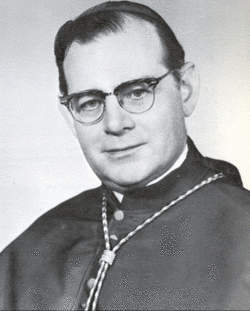
Gerald Francis O'Keefe was a 20th-century bishop of the Catholic Church in the United States. He served as auxiliary bishop for the Archdiocese of Saint Paul in the state of Minnesota from 1961 to 1966 and bishop of the Diocese of Davenport in the state of Iowa from 1966 to 1993.
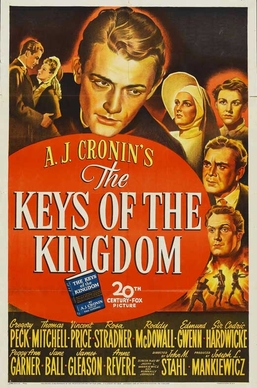
The Keys of the Kingdom is a 1944 American film based on the 1941 novel The Keys of the Kingdom by A. J. Cronin. The film was adapted by Nunnally Johnson, directed by John M. Stahl, and produced by Joseph L. Mankiewicz. It stars Gregory Peck, Thomas Mitchell, and Vincent Price, and tells the story of the trials and tribulations of a Roman Catholic priest who goes to China to evangelise.

The World, the Flesh, and Father Smith is a 1944 novel by Scottish writer Bruce Marshall. The book was a June 1945 Book of the Month Club selection and was also produced as an Armed Services Edition.

St. Thomas the Apostle Catholic Church is a Roman Catholic church and parish in the Los Angeles Archdiocese, Our Lady of the Angels Pastoral Region. The church is located at 2727 W. Pico Boulevard in the Byzantine-Latino Quarter of Los Angeles, California. The Mission Revival style church was built in 1904.

St. Mary of Ostrabrama is a historic Polish Roman Catholic church at the junction of Jackson Street and Whitehead Avenue in South River, Middlesex County, New Jersey, United States.

Fabián Edgardo Marcelo Pedacchio Leániz known as Fabián Pedacchio is an Argentine priest of the Catholic Church who served from 2013 to 2019 as a personal secretary of Pope Francis. He works on the staff of the Congregation for Bishops where he worked from 2007 to 2013. Before that, in Argentina, he fulfilled assignments as a parish priest for fifteen years and served on church tribunals at the national level.

Saint Stephen Martyr Catholic Church is a Catholic parish church located at 2436 Pennsylvania Avenue NW in Washington, D.C., in the United States. The parish was founded on August 4, 1867, and the first church building consecrated and used for worship on December 27, 1868. This brick structure closed on July 15, 1959, and the current new building was consecrated and first used for worship on June 11, 1961. The church was a favorite of President John F. Kennedy.